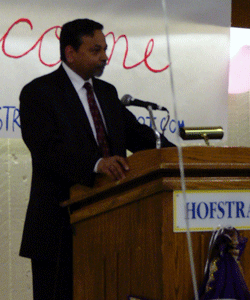By Nidhi Mahendroo
Light up your life…with Diwali, the Hindu festival of lights. On Nov. 11, the South Asian Students Association (S.A.S.A) held its first annual Diwali Dinner in honor to celebrate this auspicious day. Diwali’s beginning is marked by the Epic tale of the Ramayana and the battle of good over evil between Lord Ram and the evil King Ravan.
It is celebrated for five continuous days, each symbolizing something different. The first day is called Dhanteras, which marks the start of Diwali. Traditionally, women buy something in silver or gold, or purchase some new utensils. Their houses are cleaned thoroughly, decorated with lighted lamps called diyas, and the entrances are adorned with colorful Rangoli motifs to welcome the Goddess of wealth and Prosperity, Laxmi. Day two marks “Choti Diwali,” a small Diwali celebration with fireworks and sweets being distributed throughout friends and family. The third day is the Main Diwali, in which families hold a prayer called a “pooja” in hopes that Goddess Laxmi will bless their homes. It is on this day when Hindus light up fireworks to honor Lord Ram and remember its value of good over evil. Day four is called Annakoot, the mountain of food. Families offer a variety of food to God and pray for an abundance of food in return for their families. They give thanks to what has been given and remember the significance of this day. The fifth and final day of Diwali is marked by Bhaya-Duj, or Tika. This is a day for sisters to honor their brothers. They feed them sweets and adorn their foreheads with vermilion. Brothers in return offer to protect their sisters from harm and promise to always keep them in high spirits.
Like many other holidays, Diwali is celebrated throughout the South-Asian culture. In addition to celebrating the festival of lights, it is also considered to be the New Year, and followers pray for new opportunities in the upcoming year. Similarly, S.A.S.A had celebrated this auspicious occasion by holding a dinner for all to attend. S.A.S.A is an organization for Hofstra’s South Asian students. “We strive to educate those around us with our culture and background as well as the political issues that affect our South Asian community as well as the American community” Nadia Kahnauth, president of S.A.S.A., said. “We welcome students from different aspects of the South Asian culture, from all different aspects of the world.”
Those attending the dinner were graced with a commentary from its advisor, Mr. Stanley Cherian, and guest lecturer, Professor Anil Mathur from the University’s Frank Zarb School of Business who gave an inside scoop on what Diwali is and how it is celebrated. There were cultural dances done by students as well as a raffle giving away University T-shirts and a cell phone. A delicious four-course dinner was served, catering to both vegetarian and non-vegetarian tastes. The vegetable platter included a potato and peas filled snack called Samosas, Mixed Curried Vegetable, and Matar Paneer (Indian Cheese and Peas mixed in a curry). For the non-vegetarians, there was a choice of Buttered Chicken, which is a chicken dish mixed in a cream and butter based curry, as well as Tandoori Chicken, which is a dried Chicken dish mixed with Tandoori paste and various spices. Both dishes were served with Naan (Indian bread) and Rice. There were many South Asians and non-South Asians who came and enjoyed in the festivities. Everyone enjoyed the food, music and cultural lesson on Diwali. They stuffed their stomachs with the delicious dinner and sweets that followed, and it was noted that everyone walked out with smiles on their faces The S.A.S.A Diwali Dinner is viewed as a success and the participants hope that all the coming holidays are celebrated, they wish for all South Asians to have a Happy Diwali and a prosperous new year.

The South Asian Students Association hosted a dinner with guest speakers this past Thursday night. (Nidhi Mahendroo/The Chronicle)
